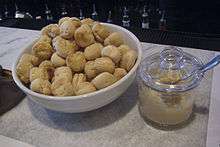Oyster cracker
 A bowl of oyster crackers | |
| Alternative names | water cracker |
|---|---|
| Type | Cracker |
| Place of origin | United States |
| Region or state | Northeast |
| Creator | Adam Exton |
| Main ingredients | Enriched flour, shortening, Leavening (baking powder), yeast, sugar, salt |
|
| |
Oyster crackers are small, salted crackers, typically rounds about 0.59 in (15 mm) in diameter, although a slightly smaller hexagonal variety is also prevalent. They are often served with oyster stew, but oyster crackers do not contain oysters. They are similar in ingredients and flavor to saltine crackers.
In cuisine
Oyster crackers are popular in the northeastern United States, where they are served as an accompaniment to soup, and in the Cincinnati area, where they are frequently served with the city's distinctive chili. In New England, oyster crackers are served in oyster stew and chowders. Additionally, plain oyster crackers are sometimes seasoned with spices.They usually have a taste similar to saltine crackers, but far less salty. In other areas of the United States, they are among the choices for crackers with soup. They are often available in single serving packages for restaurant use.
Many different companies produce oyster crackers with different combinations of shortenings and other ingredients, but retaining the same general shape and size.
Etymology
The origin of the term "oyster cracker" is unclear, but it may be that they were originally served with oyster stew or clam chowder or merely that they look like an oyster in its shell.[1] According to the web site of the still-extant bakery discussed below, the crackers were so named because they were commonly served with oyster stew and other oyster dishes (at least on their early packages). Other names include "water cracker," "Philadelphia cracker," and "Trenton cracker".[2]
Origins
The Westminster Cracker Company of Rutland, Vermont, has been making oyster crackers since 1828.[3] But Adam Exton is credited for inventing the oyster cracker.
Adam Exton, a baker in Trenton, New Jersey, emigrated to America from Lancashire, England, in 1842.[4] In Trenton, Exton opened a cake and cracker bakery with his brother-in-law, Richard Aspden, in 1846. Although Aspden died the following year, Exton continued with the bakery (the "Exton Cracker Bakery" or "Adam Exton & Co."). He invented a machine that rolled and docked pastry and solved the sanitary problems of hand-rolling crackers.
The history of the oyster cracker was related by Exton's nephew, also named Adam Exton, in the Trenton Evening Times Newspaper on May 31, 1917:
Even a cracker has a history. The past, present and future of the little disc of baked dough with "Exton" stamped across the face of it was discussed by Rotarian Adam Exton, of the Exton Cracker Company, at the weekly meeting of Trenton Rotary Club held this afternoon at Hildebrecht's... Manufacture of the Exton oyster cracker was started in Trenton, in the same location now occupied by the company's factory of Center Street, in 1877. Adam Exton, uncle of the speaker, was the originator of the oyster cracker. At the outset the factory had an output of 100 pounds of crackers a day, 36 of them to a pound, making a daily capacity of 3,600 crackers.
See also
References
- ↑ http://www.thekitchn.com/whats-an-oyster-cracker-ingredient-intelligence-214858
- ↑ Cornelius Weygandt (1939). General Magazine and Historical Chronicle Vol XLI Numb 2 January 1939. University of Pennsylvania. pp. 346–. Retrieved 7 May 2013. Quote: "I have had letters from Denver and from Pasadena about oyster crackers those oyster crackers some of us called water crackers some of us Philadelphia crackers some of us Trenton crackers Both of these men said they had oyster stew once a week the Denver man on Saturday night the Pasadena man on an unspecified day The one sent to Philadelphia for the crackers the other insisted on Exton crackers"
- ↑
- ↑ Adam Exton at Find A Grave Accessed on 13 May 2008.